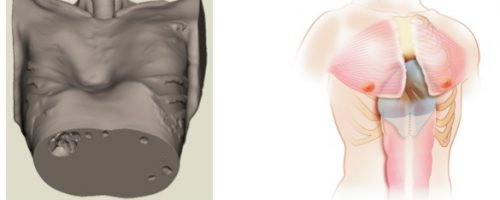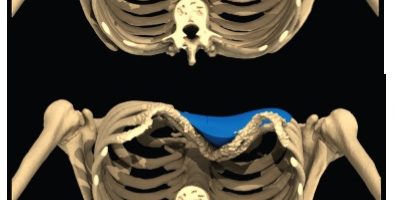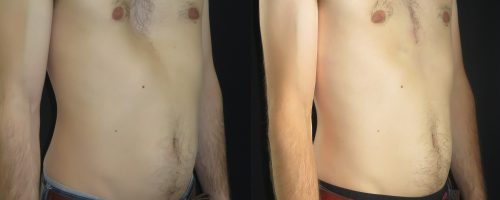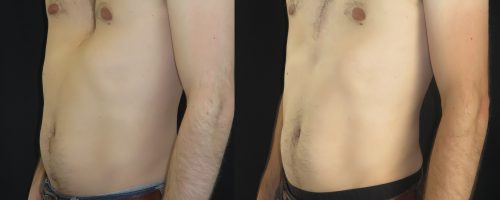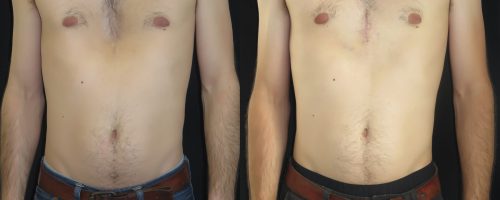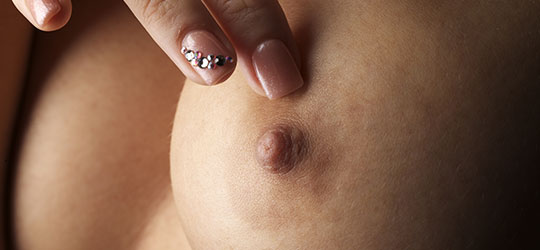Dr Vincent Nguyen is a French board-certified plastic surgeon expert and referent in chest deformities in France.
Pectus excavatum or funnel chest, is a known deformation but people don’t always know that it can be treated. Some years ago, the surgeries that addressed this condition were invasive, and left sequels. But recently, custom-made sternal implants have revolutionized the treatment. The procedure is quick, simple, customized, with simple recovery and no sequels. The result looks very natural.
Pectus excavatum treatment may be considered as reconstructive chest surgery.
- Revolutionary technique in the treatment of sunken chest
- Easy procedure, custom-made, reliable and permanent
- Minor scars, physical and psychological improvement
- Easy recovery, painless procedure
PECTUS EXCAVATUM TREATMENT OVERVIEW
This information sheet is issued by Dr. Vincent Nguyen, board-certified plastic surgeon in Paris, familiar with the treatment of sunken chest.
It provides all the information about the surgery, scars, recovery, before and after comparison photographs, Social Security coverage and the costs of sunken chest procedure.
What is a sunken chest?
Pectus excavatum or sunken chest is a congenital chest abnormality present at birth. It is the most common chest wall deformity that affects 1 to 2 % of the population (1 case in 3 00 births to 1 case in 1000 births).
Its main characteristic is a depression of the sternum, in the middle of the chest or on the side, that gives a caved-in, funnel-shaped appearance to the chest.
It may occur in men and in women.
Many patients with this condition do not know that it may be treated.
Are there several types of pectus excavatum?
Yes, as classified by Chin:
- Type 1: the malformation is symmetrical and narrow
- Type 2: the malformation is symmetrical and large
- Type 3: the malformation is asymmetrical and on one side only.
What are the treatments for a pectus excavatum?
For decades, thoracic surgeons have performed sterno-chondroplasties to entirely restructure ribs and sternum position structurally, either by turning the sternum over (Ravitch technique) or by fixing surgical metal bars through thoracoscopy (Nuss procedure). Both techniques are invasive and involved morbidity, complications and visible scars.
Today, since absence of functional, cardiac and respiratory effects has been proven, filling procedures are used to treat this funnel: with lipofilling (injection of fat) for mild deformities and patients who have enough fat stock, or with a custom-made implant (with computer-aided design from a patient’s CT scan) for more severe ones.
These technical innovations provide a successful and minimally invasive treatment with less risks of complications. The procedure is quick, the recovery simple and the scars are reduced.
PRINCIPLES OF PECTUS EXCAVATUM TREATMENT WITH CUSTOM-MADE IMPLANT
What are indications for a correction of chest deformity with custom-made implants?
The 3 different types of pectus excavatum as described by Chin, may all be treated with custom-made implants produced by computer-aided design (CAD).
How is the implant designed?
The implant is made with computer-aided design (CAD). The computer designs a 3D model from a patient’s CT scan. A customized implant is then made with silicone polymer in Sebbin lab.
THE STEPS OF THE FUNNEL CHEST IMPLANT PROCEDURE
BEFORE A PECTUS EXCAVATUM PROCEDURE WITH SILICONE CUSTOM-MADE IMPLANT:
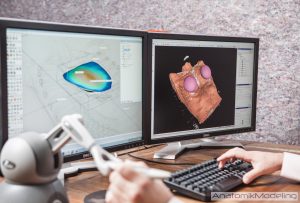
- Two preoperative consultations with a board-certified plastic surgeon will be conducted as well as a consultation with an anesthetist.
- Before and after comparison photographs will be taken.
- A post-surgical compression garment, will be prescribed.
- Preoperative instructions are as follow:
- Quit smoking at least one month before the surgery and up to 1 month after the surgery to avoid any complication or necrosis risk.
- Discontinue any anti-platelet or blood-thinning medication 15 days before the surgery.
PECTUS EXCAVATUM PROCEDURE WITH CUSTOM-MADE IMPLANT SURGERY:
- It is performed under general anesthesia.
- It lasts about 1 hour.
- Dr Vincent Nguyen uses the most advanced surgery techniques that avoid the use of drains, and performs the surgery himself.
The final result is visible about 3 months after the procedure, but the physical and psychological improvements are immediate.
AFTER A PECTUS EXCAVATUM PROCEDURE WITH CUSTOM-MADE SILICONE STERNAL IMPLANT:
- This chest surgery is not a painful surgery. Only light analgesics will be prescribed.
- Patients may go home the following day or 2 days after the procedure.
- Swelling and bruising appear on the chest the following days.
- No nursing care is required after the surgery.
- You may have a shower the day following the surgery but you can’t have a bath before a month.
- All sutures are made with absorbable material and under the skin, it is not necessary to take them off.
- The compression garment must be worn night and day for 6 weeks to avoid bad scarring.
- Avoid sun on the scars for at least a year.
- Most patients may go back to work 15 days after the surgery, depending on the nature of their job.
- You may resume physical activities after 3 months.
- Follow-up consultations with Dr Vincent Nguyen will be scheduled (1 week, 1 month, 3 months, 6 months and a year after the surgery).
FUNNEL CHEST WITH CUSTOM-MADE IMPLANT: PRICE AND COSTS
- The cost of the surgery may be covered by Social Security and excess of fees by health care mutual. But there is no coverage for the implant. Depending on its size it may cost 1800 € to 2600 €.
- The costs may vary depending on the patient, on the type of implant, on the scars, on its combination with a lipofilling procedure, on the location of the surgery, on the length of the procedure and other related expenses. The costs may vary from … To … (find all the costs on this website).
- There may be a significant contribution of the Social Security and health care mutual.
- Make sure to find a board-certified plastic surgeon expert in chest deformity surgeries who will evaluate your needs, discuss your expectations and your options to achieve the best results.
PECTUS EXCAVATUM WITH CUSTOM-MADE CHEST IMPLANT FAQs
What is the implant made of?
The chest implant is made of solid silicone, not of gel silicone. It is a highly stable material which doesn’t degrade and has an unlimited life span. The implant won’t have to be replaced.
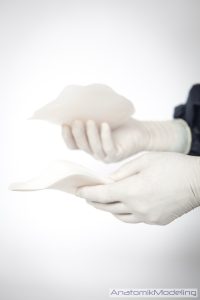
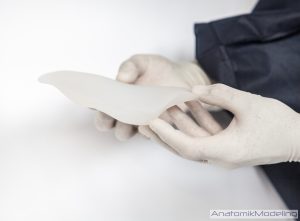
What are the advantages of a customized implant?
Custom-made implant conforms to the patient’s unique morphology and defects. The implant is invisible and the esthetic benefits are immediate.
The physical improvement is immediate and requires only one procedure.
What are the benefits of a custom-made implant or of a lipofilling procedure to treat pectus excavatum?
Compared with previous procedures, these new procedures are less invasive and less drastic than orthopedic surgeries (Nuss, Ravitch). The patient only stays 1 to 3 days in the hospital. The risks of complications and comorbidity are reduced.
These procedure are less painful. Patients may go back to work after 2 weeks and may resume sport activities after 3 months. The result remains stable over time and permanent.
Where are the scars after pectus excavatum with custom-made implant surgery?
The scars depend on the chest malformation. Usually there is a scar below the breast or in the sternum. The scars fade over time and they become almost invisible.
Pectus excavatum in women
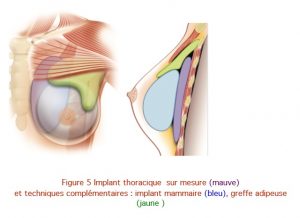
Women with pectus excavatum often complain about bust deformity, breast asymmetry, drooping breast strabism. This may cause specialists not diagnose a funnel chest deformity and, in that case only the breasts are addressed. But only the treatment of the chest will improve the alleged breast defect.
What are the alternatives to custom-made sternal implant?
Besides the invasive surgical orthopedic procedures, lipofilling may be an alternative to correct a mild defect. But he patient must have enough fat stock.
Can implant procedure be combined with lipofilling?
Lipofilling may be associated with sternal implant procedure. Or there might be a lipofilling later to improve the result.
Has pectus excavatum functional, cardiac or pulmonary consequences?
The last studies tend to demonstrate that it has no effect on cardiac or respiratory functions except when combined with other deformities.
Does Pectus excavatum condition psychologically affect patients?
Sometimes, the deformities are such, that patients consider their condition as a physical disability. The psychological impact prevents them from being bare chested in private or in public (swimming-pool, beach, changing room …) and they often have no self-confidence.
Can I have a breast augmentation with implant after a custom-made funnel chest implant procedure?
Yes, you may have a breast augmentation with implant or with lipofilling after a funnel chest treatment but not at the same time. You will have to wait about 6 months after the first procedure.
Can I have a funnel chest implant procedure after a Nuss or Ravitch treatment?
Yes, it is very common now to have a custom-made implant procedure if the results of the first procedure are not fully satisfying.
As it is customized, the implant conforms to the chest transformation. The surgeon uses the existing scars and doesn’t make new ones.
How long will I have to wait between the consultation and the surgery?
It requires about 2 months to have a customized implant made.

